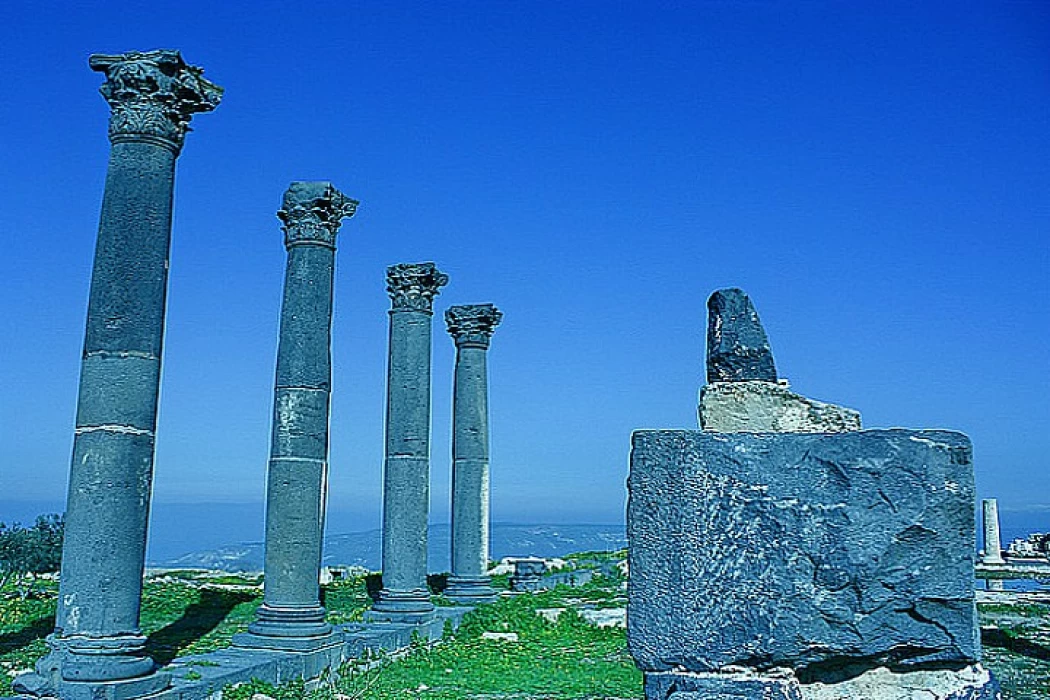
Umm Qais | Jordan Attractions
Umm Qais
Perched on a beautiful hill overlooking the Jordan Valley and the Sea of Galilee, the city of Umm Qays boasts impressive ancient remains, such as the splendid black basalt theater, the basilica, and the adjacent courtyard littered with finely carved black sarcophagi, the road main colonnade and a side street lined with shops, an underground mausoleum, two bathrooms, a nymphaeum, a city gate and the few remains that trace the contours of what was once a huge hippodrome.
In Hellenistic times Umm Qais, like most of Jordan, was conquered by the Ptolemies and the Seleucids - parts of the walls and the base of a temple date back to that time. The city was then conquered by Alexander Jannaeus in 83 B.C and some Nabatean finds indicate the presence of that population as well. Freed from the domain of Hasmonaean by Pompeo in 63 A.D, it was under the Roman Empire as one of the cities of the Decapolis.
Umm Qais is renowned for its vibrant intelligent life and as the birthplace of some important writers and scholars of the ancient world, prosperity continued throughout the Byzantine era when Umm Qais was the seat of a bishopric. His association with one of Jesus' miracles elevated his status to a pilgrimage site, and the five-aisled basilica was built to house pilgrims. While continuing to thrive after the Islamic conquest of 636, the city began to decline after the Abbasids defeated the Ommayyads in 750, who moved the center of the caliphate to east Baghdad.
Umm Qays
A well-traveled bridge between sea and desert, east and west, the Hashemite Kingdom of Jordan is a land of mesmerizing beauty and contrasts, from the Jordan Valley, fertile, and ever-changing, to the remote desert canyons, immense and still. Visitors can explore splendid desert castles, gaze in awe at the haunting wilderness of Wadi Rum, or bathe in the restful waters of the Red Sea.
Jordan Attractions
Latest Articles
Admin
Seabourn Sojourn Cruise Stops in Safaga Port
The Seabourn Sojourn, the flagship vessel of Seabourn Cruise Line's ultra-luxury fleet, was built in 2008 at the T. Mariotti shipyard in Genoa, Italy. Measuring 198 metres, it can accommodate up to 450 guests in its 225 spacious all-suite staterooms.
Admin
Norwegian Sky Cruise Stops in Safaga Port
Norwegian Cruise Line operates a cruise ship called the Norwegian Sky. It was constructed in 1999 and can accommodate 2,004 passengers in addition to 878 crew members. The ship has several dining establishments, lounges and bars, a spa and fitness center, swimming pools, and a number of entertainment areas.
Admin
Explora II Cruise Stops in Safaga Port
Explora II, the second vessel in the Explora Journeys fleet, sets sail in 2024 to redefine luxury cruising. With 461 ocean-front suites, 9 culinary experiences, and 4 pools, this haven of sophistication and sustainability promises an unforgettable "Ocean State of Mind" journey to inspiring destinations.
Admin
Mein Schiff 6 Cruise Stops in Safaga Port
The Mein Schiff 6 is the latest cruise ship in the renowned TUI Cruises fleet, offering passengers a luxurious and sophisticated cruise experience. At 315 metres long, this floating resort features a range of dining options, entertainment, and recreational facilities, including a spa, fitness centre, and sports amenities.
Admin
Mein Schiff 4 Cruise Stops in Safaga Port
When the Mein Schiff 4 cruise ship docks in Safaga, Egypt, passengers are granted access to a realm of ancient wonders. Aboard this state-of-the-art vessel, guests can embark on meticulously curated shore excursions that showcase the region's most iconic landmarks, including the Giza Pyramids, the enigmatic Sphinx, and the remarkable tombs and temples of the Valley of the Kings in Luxor.
Admin
MS Europa Cruise Stops in Safaga Port
The Silver Moon, Silversea's latest flagship, is a luxury cruise ship that offers an exceptional travel experience for Venezuelans exploring Egypt. With a capacity of 596 guests and an impressive 40,700 gross tonnes, the Silver Moon maintains the small-ship intimacy and spacious all-suite accommodations that are the hallmarks of the Silversea brand.













